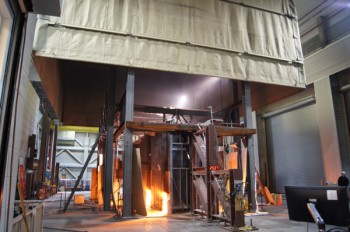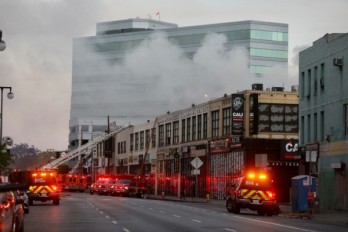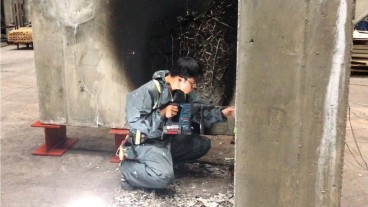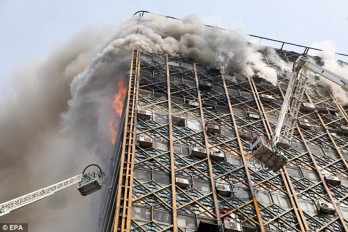Current fire blanket technology can protect infrastructure from wildfires

According to a new study, the existing fire blankets are potentially capable of protecting buildings exposed to wildfires.
As urban infrastructure further develops covering increasingly larger areas, wildfires pose a severe threat to buildings and human life. Therefore, protecting a structure that is subjected to such fires is a significant challenge.
The current research was motivated when people living in fire prone areas contacted Fumiaki Takahashi, lead author of the study and Professor at Case Western Reserve University of Cleveland. They wished to find out whether common materials could protect a structure from a wildfire. “I thought about a means to reduce wildland fire damage and found a U.S. patent ‘conflagration-retardative curtain’ i.e., a fire blanket, issued during World War Two. In addition, the U.S. Forest Service firefighters managed to save a historic forest cabin by wrapping it with their fire shelter materials,” Prof. Takahashi, stated.
A number of fabric materials were subjected to laboratory testing in order to determine if they can protect buildings. In particular, 4 fabric materials (fiberglass, pre-oxidized carbon, aramid and amorphous silica) each laminated with or without an aluminum foil, were tested to derive their insulation capacity against radiation heat or fire contact. Moreover, scale testing from small structures (e.g. a birdhouse) to a full-size repository was conducted. The fiberglass and amorphous silica fabrics laminated with aluminum surface performed best as they presented high reflection and emission of heat radiation.
The results showed that current blanket technology could perform well and save a building from severe damage if exposed to a short duration of wildfire. Nevertheless, those materials and their implementations methods should evolve in the future to increase the chances of success. "The whole-house fire blanket is a viable method of protection against fires at the wildland-urban interface. Current technology can protect an isolated structure against a relatively short wildfire attack and further technological developments are likely to enable this method to be applied to severe situations,” Prof. Takahashi added.
Difficult tasks that arise include the application of the method in a multi-structure system to protect a community and the feasibility of the aforementioned materials to withstand a fire with longer duration.
Prof. Takahashi emphasizes that fire blanket technology would highly reduce the risk that people living in fire prone areas are exposed.
Source: Frontiers
Source: Frontiers
Want to read more like this story?

Construction Site Inferno: Fire Hazards in Large-Scale Projects Exposed
Feb, 14, 2025 | NewsA devastating fire at a luxury hotel construction site in Busan, South Korea, has raised critical c...
Building collapses in north Delhi due to fire
Mar, 02, 2023 | NewsA big fire started on Wednesday inside a three-story private building on Roshanara Road in North De...

Study on the impact of fires in high-rise buildings
Apr, 21, 2020 | NewsResearchers from the U.S. National Institute of Standards and Technology (NIST), conducted a thoroug...

High tower in South Korea engulfed in fire
Oct, 19, 2020 | NewsA 33-story building was engulfed in fire but, fortunately, it was put under control without any fata...

Building explosion in Los Angeles: 12 firefighters injured
May, 26, 2020 | NewsAt least 12 firefighters were injured and many buildings were damaged after an explosion occurred in...

Fire-damaged concrete structures: how do we know when to fix or rebuild a concrete structure after a fire?
Nov, 22, 2021 | NewsGenerally, when concrete is exposed to intense fire, materials in the concrete can decompose, and c...

Construction crane’s boom collapses on building in New York City
Jul, 26, 2023 | NewsA construction crane’s boom collapsed on a nearby building after it caught on fire on Wednesday, Ju...

At least 20 under-construction homes destroyed by fire in Vaughan, Ontario
Apr, 12, 2023 | NewsA massive fire destroyed at least 20 $2-million-houses of a new under-construction development in V...

Tehran’s Pasco building collapses after fire
Jan, 19, 2017 | NewsPlasco commercial building, an iconic high-rise structure in central Tehran, collapsed following a f...
Trending

Vertical gardens in Mexico City to combat pollution

Saudi Park Closed After 360 Big Pendulum Ride Crashes to Ground, 23 injured

Characteristics of Load Bearing Masonry Construction

Taipei 101’s impressive tuned mass damper

Dutch greenhouses have revolutionized modern farming

Federal court rules Biden’s offshore drilling ban unlawful


